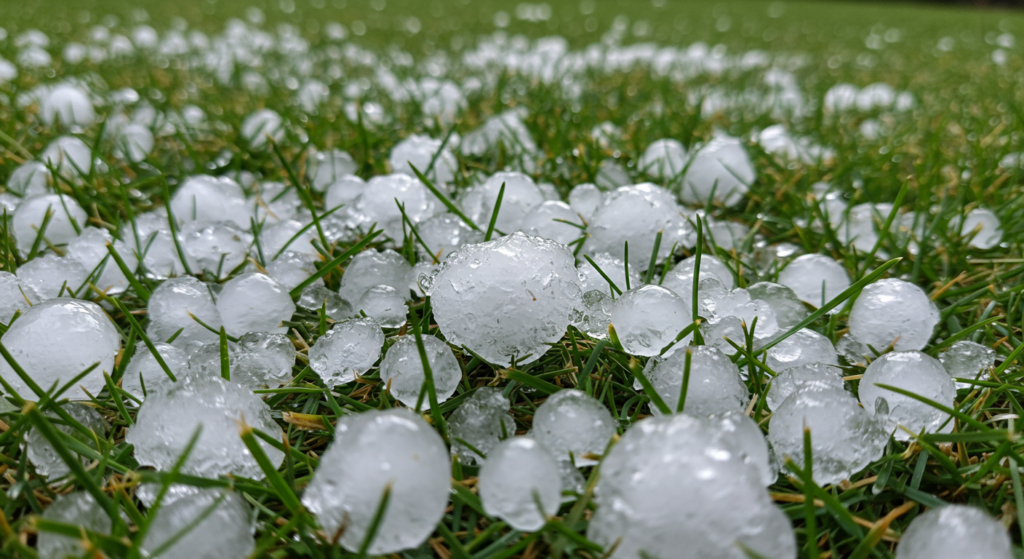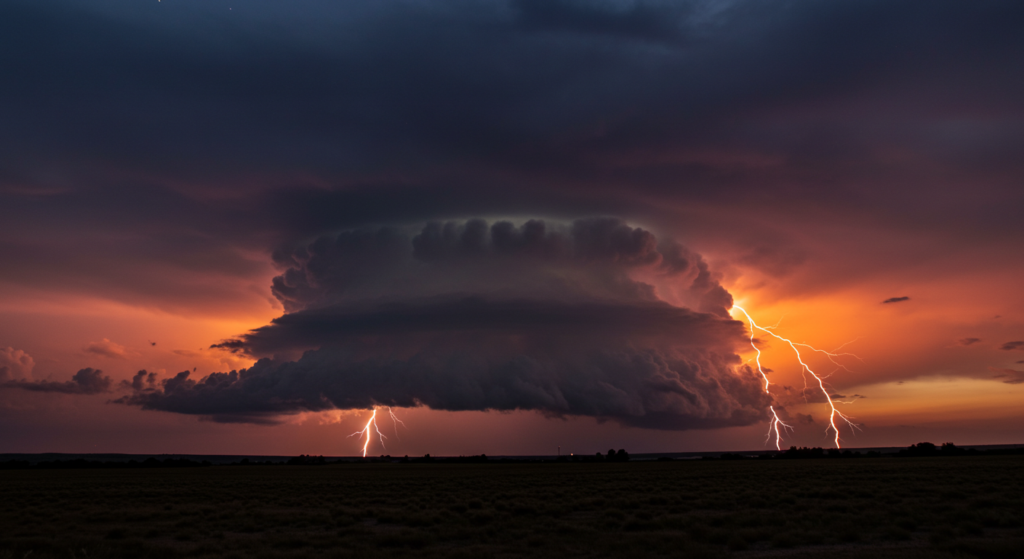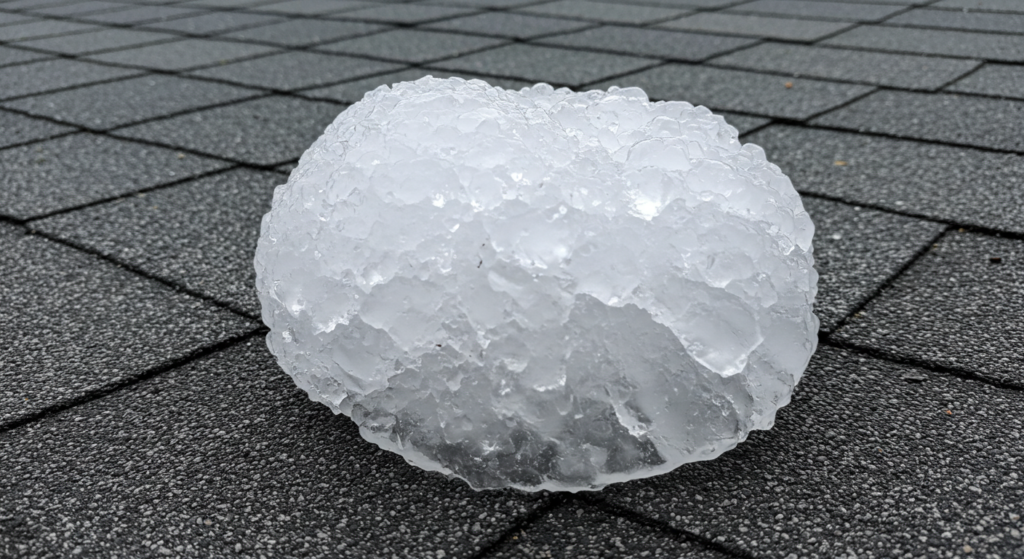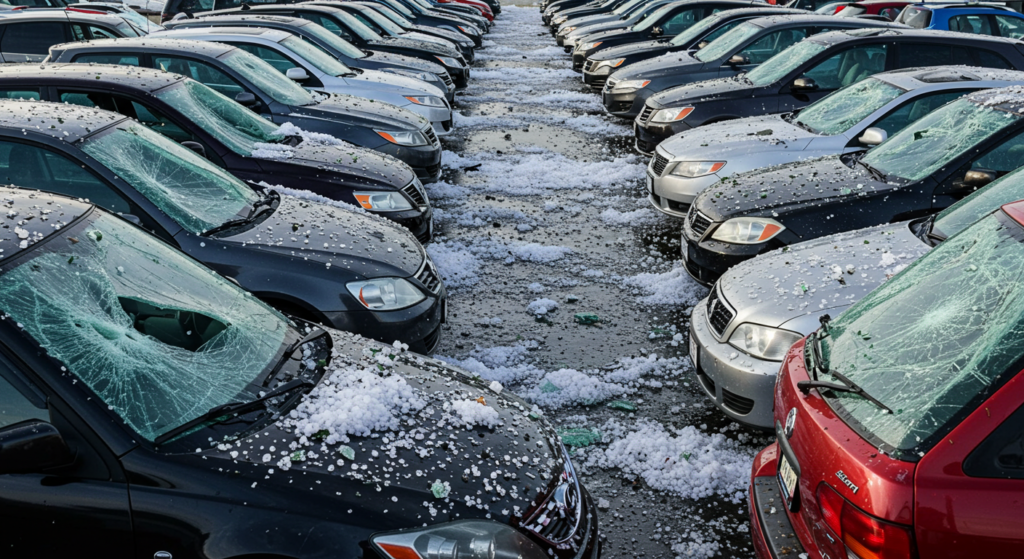In Texas, the severe weather can turn a calm day into a scene of chaos, damaging property and creating hazards in mere moments. Few natural phenomena disrupt daily life as quickly or forcefully as frequent hail, leaving many to wonder: why does a giant ball of ice happen? Understanding the science behind these icy projectiles equips us to better predict the path of a hail core and mitigate their effects.
Hail forms under particular atmospheric conditions, largely influenced by powerful thunderstorm updrafts and the intricate dance of updrafts and freezing processes. From the birth of a small ice pellet to the growth of a full-sized hailstone, multiple factors, including supercooled water droplets and storm duration, govern the final size and impact of the hail. Awareness and comprehension of these processes allow for improved safety measures and forecasting techniques.
This article delves into the complex world of hail formation, with a focus on its peculiar prevalence in Texas’ climate. By exploring everything from the basic characteristics of hailstones to cutting-edge detection technology and effective safety strategies, readers will gain a comprehensive understanding of this icy nuisance and learn how to protect themselves against its unpredictable force.
So why does hail happen? Read on to learn more.

Why does hail happen? The Basics of Hail
Hail is an intriguing weather phenomenon that results from the unique conditions within thunderstorms. Chances for hail begin when strong updrafts carry water droplets above the freezing level in storm clouds, turning them into ice crystals. As these ice crystals are moved up and down within the cloud by continued updrafts, they gather more supercooled water, growing into hailstones. The strength of these updrafts is vital, as they determine the eventual size of the hailstones and the amounts of hail. Interestingly, hail can form during warm weather since the temperatures high up in the cloud are cold enough for ice formation. In the U.S., hailstorms are common in the South Central region, where specific atmospheric conditions make strong thunderstorms more likely. Texas is in the bullseye.
Definition of Hail
Hail is a unique type of solid precipitation consisting of balls or irregular lumps of ice known as hailstones. These stones are formed within thunderstorm clouds as water droplets are lifted above the freezing level. In this cold area, the droplets freeze and grow by collecting supercooled water and water vapor. Strong updrafts in the thunderstorm are crucial, as they push the raindrops to higher altitudes with freezing temperatures, resulting in hail formation. While hail can be as small as peas, it can also reach sizes similar to grapefruits, depending on the intensity of the storm. Hail is different from other freezing precipitation types like sleet, which usually appears during colder seasons and outside severe storms.
Characteristics of Hailstones
Hailstones vary in shape from spherical to conical and average hail size ranges in diameter from 5 to 50 millimeters. Most hailstones, however, are smaller than 25 millimeters. Their formation relies heavily on the conditions within the storms, especially multicell or supercell storms that have strong updrafts. As hailstones are repeatedly cycled through these updrafts, they gather layers of ice, increasing in size. The largest hailstones form when the updrafts are strong and last long enough to support this accumulation. The U.S. record for the largest hailstone is a remarkable 18.62 inches in diameter, weighing nearly two pounds. Hail detection has advanced with Dual Polarization radar technology, which differentiates hailstones based on their shape and reflective properties compared to rain.
Why does hail happen? The Formation Process of Hail
Hail forms through a fascinating process within thunderstorms. It happens when strong updrafts lift water droplets high into the atmosphere. Once above the freezing level, these droplets turn into ice. As they are carried upward, they collide with supercooled water droplets. Each collision grows the hailstone, adding layers of ice. Eventually, the stones become too heavy for the updrafts and fall to the ground as solid precipitation. The size of hailstones depends on the strength of the updraft, with stronger winds producing larger hailstones. Understanding this process can help in predicting hail storms and their potential impact.
Role of Thunderstorms
Thunderstorms are crucial in the formation of hail. In the United States, the geography supports frequent strong storms, making hail a common event. Both hail and tornadoes can form from the same atmospheric conditions. In a thunderstorm, strong updrafts lift water droplets high, where they freeze and grow into hailstones. Supercell thunderstorms are especially known for producing large hail due to their powerful updrafts. These storms cycle hailstones several times through the cloud before they fall. The larger the hailstone, the stronger and longer the updrafts have held it aloft.

Updraft Mechanics
Updrafts play a pivotal role in hailstone growth. Strong updrafts allow hailstones to grow larger, as they lift them repeatedly into the colder parts of a cloud. This process, known as accretion, adds layers of ice to the stones. Supercell thunderstorms produce the strongest updrafts, allowing hailstones to stay suspended longer and grow bigger. As hailstones are lifted above the freezing line, they refreeze and accumulate more layers. Once the updrafts can no longer support their weight, these stones fall to the ground, forming a hail storm.
The Freezing Process
The freezing process is key in hail formation. Updrafts lift water droplets above the freezing level, transforming them into ice. These hailstones continue growing as more layers are added during subsequent lifts. In a storm, hailstones must reach a significant size and mass to survive the fall without melting. The updrafts’ ability to support them dictates how often they are lifted and frozen again. Eventually, when the hailstones are too heavy for the updrafts, they descend, completing the freezing precipitation process.
Growth of Hailstones
Hailstones grow as updrafts carry ice crystals above the freezing level. The ice accumulates more layers of supercooled water each time it cycles through the cloud. The updraft’s strength and duration within the cloud largely determine the stones’ size. In strong thunderstorms, hailstones can be lifted multiple times, each pass adding new layers of ice. Supercell thunderstorms are efficient at growing large hail, with intense updrafts sustaining hailstones longer. Once a hailstone gets too heavy, it falls, often causing hail damage when it hits the ground.
The Role of Supercooled Water Droplets
Supercooled water droplets are essential for hailstone growth. When these droplets freeze upon contact with a frozen droplet, they add layers to the hailstone. As updrafts carry these droplets above the freezing level, they continue to accumulate, enlarging the stone. Thunderstorms facilitate this process by lifting and dropping hailstones through layers of supercooled water, forming layered ice. Particularly in supercell thunderstorms, the abundance of these droplets leads to large hail. The presence of supercooled water in strong updrafts is crucial for the development of significant hailstones.
Factors Influencing Hail Size
Hail size is determined by several factors within thunderstorms, particularly the strength of updrafts. These updrafts are the rising currents of air in a storm. The stronger they are, the larger the hailstones can grow. As these stones are lifted high into cold regions of the atmosphere, supercooled water droplets freeze onto them. This process, called accretion, allows the hailstone to develop layers of ice. For the largest hailstones to form, they must remain within the storm for a long time to continue gathering layers. Supercell thunderstorms, known for their intense updrafts, can produce the largest hailstones. These updrafts can reach speeds over 100 miles per hour, lifting stones higher and allowing them more time to grow. The size of hailstones, ranging from less than a ping pong ball to baseball size hail, depends on how long they stay suspended in the cloud. As they circulate in the storm cell, they continue to grow before finally falling to the ground.

Atmospheric Conditions
Atmospheric conditions are key ingredients in hail formation. During thunderstorms, strong updrafts transport water droplets into high altitudes where temperatures drop significantly. Here, the droplets freeze into ice crystals, and the varying water vapor concentrations they encounter give hailstones their layered appearance. To support hail formation, the land temperature must be mild enough to create shower clouds, while the surrounding atmosphere should be cold enough for ice to form. In regions like Britain, the occurrence of hail is more common in spring. During this time, conditions in the atmosphere are perfect for freezing droplets. However, the largest and most destructive hailstorms typically develop during the summer. In such storms, hailstones can vary greatly in size. Multicell storm clusters often produce surprisingly large stones, sometimes the size of ping pong balls or even reaching the largest diameter records.
Duration of Storms
The duration of a hailstorm, though usually brief, can have a big impact. Most hailstorms last between 5 to 10 minutes, but in this short time, they can cause significant hail damage. That’s because even a brief onslaught of baseball size hail can wreak havoc on crops, vehicles, and infrastructure. These storms can be quite localized, with some affecting one side of a road while the other remains untouched. This sporadic nature is common in isolated thunderstorms. When hailstorms move slowly, the hail may accumulate on the ground like snow. An example of this occurred in Denver where a storm led to a foot of hail accumulation. In regions with the right atmospheric conditions, a stationary storm can cause significant piling of hail. While Britain’s most severe hailstorms occur in summer, they are less frequent compared to shorter hail events in other areas. This makes them particularly notable when they do occur.
Hail’s Terminal Velocity and Impact
Hailstones vary in size and, as they grow larger, their terminal velocity increases. This is the maximum speed they reach when falling to the ground. For example, baseball-sized hailstones can hit speeds of around 70 miles per hour. Even larger hailstones can reach velocities of 90 to 100 miles per hour. Such speeds result in significant damage upon impact.
Here is a brief table showing examples of hailstone size and speed:
| Hail Size | Terminal Velocity (mph) |
|---|---|
| Golf ball | ~50 |
| Baseball | ~70 |
| Larger sizes | 90-100 |
The size and speed of these hailstones make them a severe threat. Their weight and velocity can dent cars and break windshields. They are also capable of causing major damage to crops and other properties.
Key impacts of hail include:
- Dented vehicles
- Broken glass
- Damaged roofs
- Lost crops
- Occasional human injuries from hail
Being aware of hail threats and taking precautions can help reduce potential damage. Hailstorms are a natural event, influenced by atmospheric conditions, and can occur with varying frequency in different areas.

Hail Detection and Forecasting
Hail is a type of solid precipitation that can cause serious damage. Detecting and forecasting these hail events is essential to minimizing their impact. Meteorologists use advanced technologies to predict when and where hailstorms will occur. This helps in warning people and reducing damage. The main tool they use is radar technology. Radar helps in identifying where hail is likely to form and move. By understanding hail formation and using radar, experts can give accurate forecasts. This allows people to take the necessary actions to protect themselves and their property.
Radar Technology
Radar technology plays a crucial role in detecting hailstorms. Dual-Polarization, or Dual-Pol radar, is a key advancement in this field. It allows meteorologists to differentiate hail from rain. This is because hail and rain reflect radar waves differently. Dual-Pol radar measures both horizontal and vertical dimensions of these targets. This method is more accurate at identifying hail than traditional Doppler radar. It can assess the size of hail and see if it is coated with water. This helps meteorologists better predict hail events and issue timely warnings. With such data, they can understand hailstorm paths and make informed forecasts.
Warning Systems
Accurate warning systems are vital in reducing hail damage. Dual-Polarization radar is essential for these systems. It helps meteorologists distinguish between hail and rainfall, providing vital data on the extent and size of hail. This information aids in making accurate predictions and issuing warnings. Specialized radar products give details about hail’s composition and trajectory. By analyzing this data, meteorologists can forecast when the hail threat will end. These radar warnings allow people to prepare for impending storms. Such advancements in technology improve safety measures during hail events, lessening potential damage.
Hail Climatology in Texas
Hail is a frequent weather phenomenon in Texas, closely linked to seasonal changes and meteorological features like the dryline. During the winter months, hail is common along the Gulf of Mexico, affecting regions such as the Mississippi and Red River Valleys. As winter gives way to spring, the probability of hail in the South Central U.S., including Texas, rises. This is due to the dryline promoting strong thunderstorms conducive to hail formation.
When spring transitions to summer, hail risk shifts north to the High Plains as the dryline’s influence in South Central U.S. diminishes. In Texas, these dynamics lead to varied hail probabilities throughout the year.
Hail Probabilities by Season in Texas:
| Season | Probability Increase |
|---|---|
| Winter | Gulf of Mexico, Miss. and Red River Valleys |
| Spring | South Central U.S., influenced by dryline |
| Summer | High Plains as dryline weakens |
Texas faces an ever-present hail threat due to its atmospheric conditions, resulting in a higher likelihood of hail storms during specific times of the year. Understanding these patterns helps in predicting and preparing for hail damage.
Safety Measures During Hailstorms
Hailstorms can be suddenly severe and highly destructive. Hail, which can range from tiny pellets to large hailstones reaching softball sizes, poses a great threat to safety. When it’s part of a thunderstorm, hail can shatter windows and damage roofs, cars, and crops. To protect yourself and your property, it is vital to take safety measures when hail threatens. Staying informed about upcoming weather conditions is the first line of defense. The use of tools like a NOAA All Hazards radio can alert you to hazardous hail weather, helping you take action quickly. Keep in mind that standing under trees for protection isn’t safe. Lightning can strike trees, posing a risk. Therefore, understanding the importance of staying inside and avoiding risky areas during a hailstorm is crucial in ensuring your safety.
Indoor Safety Tips
Staying indoors during a hailstorm is your best defense. However, it’s important to choose a safe spot. Move into an interior room that keeps you away from windows. Hailstones, propelled by strong winds, can shatter glass, creating a risk of injury. Even after the hail stops, strong winds and lightning may still be threats, so remain sheltered until the storm has passed entirely. Windows and other glass areas should be avoided, as they are vulnerable to breakage from wind-blown hail. This precaution will not only protect you from potential glass shards but also from other storm-related hazards. These simple yet vital steps can minimize harm and ensure your safety during a hailstorm.
Driving Precautions
Driving during a hailstorm can be particularly dangerous. If you find yourself on the road, your first priority should be to pull into a safe area, such as a parking lot or the side of the road, and stop. Engaging your emergency flashers will alert other drivers to your situation. Moving through a hailstorm not only increases the risk of damaging your vehicle’s windows and windshield but also presents safety hazards. Protecting yourself is important, so turn your body towards the car’s center and use a blanket or soft material to shield your head. If your vehicle has a sunroof or moonroof, avoid sitting directly beneath them, as they are susceptible to breaking upon hail impact. By taking these precautions, you can better ensure your safety during the storm.
Why does hail happen? Resources for Further Study
Understanding hail involves exploring diverse resources and staying informed about weather patterns. Keeping updated with the latest meteorological developments is crucial for safety and education. Various platforms provide insightful data and interpretations related to hailstorm occurrences. From governmental agencies to volunteer networks, these resources offer valuable information; they help us grasp the nature, formation, and impact of hail.
Academic Papers
Though specific academic papers were not detailed in the initial guidelines, they often delve into the technical aspects of hail formation. They can provide in-depth research studies and statistical models. Researchers explore areas like atmospheric conditions and storm cell dynamics that contribute to hail development. Academic publications also analyze historical hail records, offering insights into trends and probabilities. For those interested, university libraries and academic journals are great starting points to access this rich content.
Books and Articles
While the provided information did not specify particular books or articles, there are many publications available that focus on weather phenomena, including hail. These resources often aim to educate the public about the mechanics and dangers of hailstorms. Many authors discuss the size of hail, how it forms in supercooled water droplets, and the resulting damage it can cause. Engaging with books and articles allows for a better grasp of the science and impacts of hail in an accessible format. Local bookstores and online platforms are excellent places to find these resources.
Online Courses and Workshops
Hail is a fascinating topic that can be explored through online courses and workshops, even though specific listings were not provided. These educational programs typically cover the science behind weather phenomena, including hail development, detection, and its harmful effects. Courses often focus on practical skills, such as hail detection and understanding thunderstorm dynamics. Workshops may also offer hands-on experiences with weather simulations and data analysis. Platforms like Coursera, edX, and community colleges frequently offer such courses, making them a valuable addition to formal education and personal interest.
